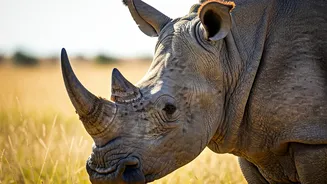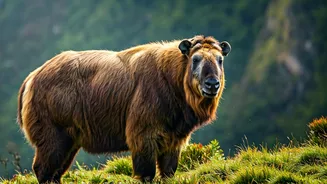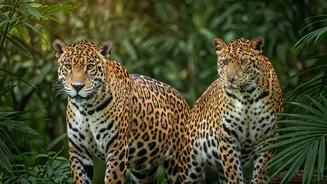Big but Plant-Eaters
Rhinos, known for their substantial size, are primarily herbivores. This means their diet primarily consists of plants. They consume a variety of vegetation,
including grasses, leaves, and twigs. The types of plants they eat can vary depending on their specific habitat. Their large bodies require a significant amount of food to sustain them. Rhinos spend a considerable portion of their day grazing and browsing to meet their energy needs. This diet is essential for their survival, contributing to their size and overall health. Their powerful jaws and teeth are perfectly adapted to grinding tough plant matter. Different rhino species have slightly different dietary preferences, depending on the vegetation available in their respective environments.
Mud Baths for Comfort
Rhinos are known for their love of mud baths, a behavior that serves multiple purposes. The mud acts as a natural sunscreen, protecting their skin from the harsh sun and preventing sunburn. The mud also helps regulate their body temperature, keeping them cool in hot environments. Beyond temperature regulation, mud baths help with parasite control. The mud dries on their skin, which then dislodges parasites. Rhinos often wallow in mud holes and puddles. The mud also provides a barrier against insect bites and other irritations. This behavior is crucial for their well-being, as it protects them from various environmental stressors and promotes their overall health, allowing them to thrive in their natural habitats.
Poor Eyesight, Strong Senses
Rhinos don't have the best eyesight, but they compensate with heightened senses of smell and hearing. They rely heavily on their sense of smell to detect danger, find food, and recognize other rhinos. Their sense of smell is incredibly sensitive, allowing them to identify specific scents from a considerable distance. Their hearing is also exceptionally acute, enabling them to pick up on sounds that may indicate predators or changes in their environment. These strong senses help them navigate their surroundings and protect them from harm. While their eyesight may be limited, their other senses provide them with valuable information about their environment. Rhinos are highly attuned to their surroundings, using their well-developed senses to compensate for their poor eyesight.
Talking in Sounds/Smells
Rhinos communicate with each other through a combination of sounds and smells. They use a range of vocalizations, including snorts, grunts, and roars, to convey different messages. These sounds can signal warnings, attract mates, or establish dominance. In addition to sounds, rhinos employ scent-marking to communicate. They urinate and defecate in specific areas, leaving behind scent signals that other rhinos can recognize. They also use the horns to mark territories. These scent markings communicate information about their identity, health, and social status. This complex communication system allows rhinos to interact effectively with each other, forming social bonds and maintaining order within their populations. The different methods of communication are essential for social cohesion.
Grey, Not Black/White
Despite being commonly referred to as black or white rhinos, these animals are actually grey. The terms 'black' and 'white' in their names refer to differences in their lip structure, not their color. The 'white' rhino got its name from the Afrikaans word 'wyd', meaning 'wide,' referring to its broad muzzle, which was misinterpreted as 'white' by early European settlers. Both black and white rhinos share a similar grey coloration, blending in with their surroundings. The specific shade of grey can vary depending on the environment, as they often get coated in mud and dust. The perception of their color may also change depending on lighting conditions, making them appear lighter or darker at times. The naming convention has caused some confusion, but it is important to remember that rhinos, regardless of their species, are primarily grey.
Horns are not Bones
Rhino horns, which are perhaps their most distinctive feature, are composed of keratin. Keratin is the same protein that makes up human fingernails and hair. The horns grow continuously throughout the rhino's life, and they are not attached to the skull. They are made of tightly packed fibers that form a dense structure. While they might seem like bone, they lack the internal structure of bone. The horns serve multiple purposes, including defense, digging, and foraging. The size and shape of the horns vary depending on the species and the individual. They are highly valued in some cultures, leading to illegal poaching. Conservation efforts focus on protecting rhinos from poachers and preserving their horns as essential parts of their anatomy.
Rhino Horns
Rhino horns are composed of keratin, the same material as human fingernails and hair. They grow continuously throughout a rhino's life, from the skin. The horns are not made of bone but are instead formed from tightly packed, fibrous proteins. These horns are used for a variety of purposes, including defense against predators, digging for food, and attracting mates. Rhino horns are also unfortunately the target of poachers, due to the high value placed on them in certain cultures, which can lead to extinction. The shape and size of horns can differ between rhino species, reflecting their unique needs and behaviors. Efforts to protect rhinos focus not only on preventing poaching but also on understanding the function of the horns in their social interactions.




